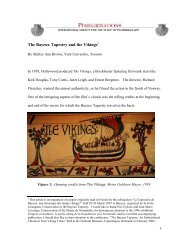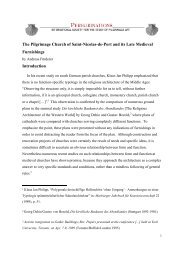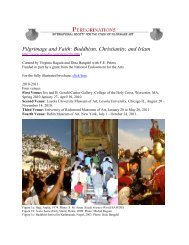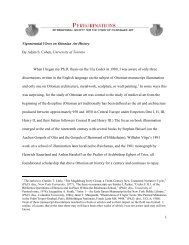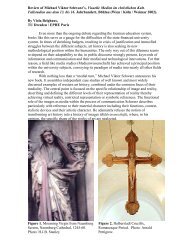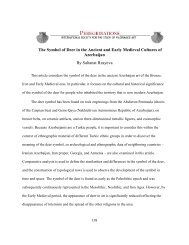The Bayeux Tapestry as a Religious - Peregrinations
The Bayeux Tapestry as a Religious - Peregrinations
The Bayeux Tapestry as a Religious - Peregrinations
You also want an ePaper? Increase the reach of your titles
YUMPU automatically turns print PDFs into web optimized ePapers that Google loves.
Byzantium. <strong>The</strong>re are also barnyard animals to be found in the <strong>Tapestry</strong>, creatures <strong>as</strong>sociated<br />
with the hunt, and of course the thundering steeds of the Norman cavalry. Decorative <strong>as</strong> all these<br />
birds and animals might seem, they were placed in the <strong>Tapestry</strong> for another re<strong>as</strong>on – to<br />
demonstrate a moral. <strong>The</strong> eleventh century saw the beginnings of the bestiaries, those<br />
encyclopedi<strong>as</strong> of animal knowledge, replete with improving morals along with often dubious<br />
information. 27 Mythical creatures such <strong>as</strong> the dragon and the wyvern, along with lions and other<br />
be<strong>as</strong>ts, entered the emerging world of chivalry.<br />
Some of the symbols to be found in the <strong>Tapestry</strong> have their roots in the cl<strong>as</strong>sical world.<br />
<strong>The</strong> phallus, for example, w<strong>as</strong> seen a sign of good fortune. <strong>The</strong> centaur, and the <strong>Tapestry</strong> is<br />
unusual in having male and female centaurs, w<strong>as</strong> a hybrid creature, part horse and part man. So<br />
too the centaur h<strong>as</strong> a double nature, representing re<strong>as</strong>on and also p<strong>as</strong>sion, vengeance and also<br />
heresy. A pair of peacocks sit together perched above Duke William‟s palace. (Figure 16)<br />
Figure 16: Peacocks. Detail from the <strong>Bayeux</strong> <strong>Tapestry</strong> – 11th Century<br />
by special permission of the City of <strong>Bayeux</strong>.<br />
<strong>The</strong>se birds evoke an image of luxury, but they also have an allegorical meaning to them. <strong>The</strong>y<br />
are depicted on Roman sarcophagi <strong>as</strong> representing eternal life, their flesh being imperishable.<br />
27 Jenneta Rebold Benton, <strong>The</strong> Medieval Menagerie: Animals in the Art of the Middle Ages (New York: Abbeville<br />
Press, 1992).<br />
153



